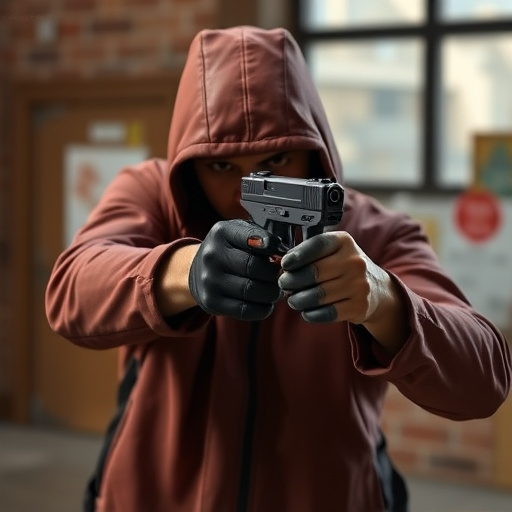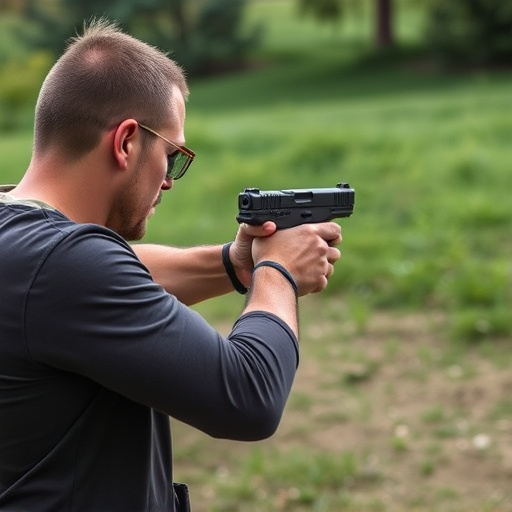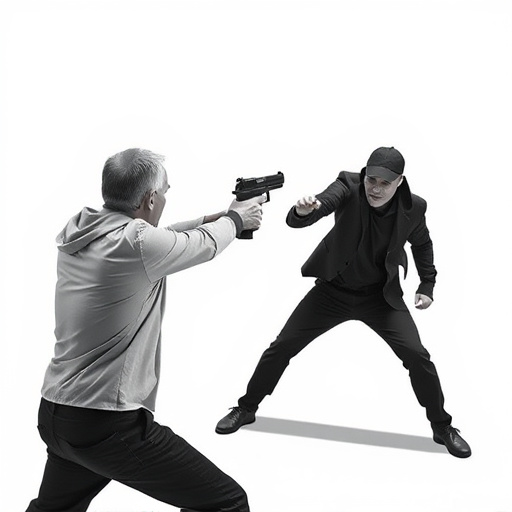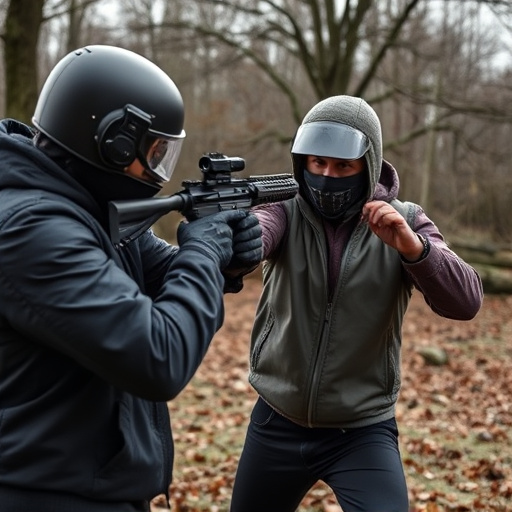Understanding voltage behavior and its interaction with materials is vital for personal safety when using best stun guns for car defense. Thicker or non-conductive fabrics reduce voltage penetration, so users should select stun guns designed to penetrate common types of clothing. Key considerations include fabric electrical resistance, thickness, and density. High-end stun guns overcome barriers to ensure deeper penetration. Choosing the best stun guns involves high voltage outputs (50,000-100,000 volts), rechargeable options, LED flashlights, and reputable manufacturers with warranties. Evaluating models requires understanding standardized testing methods and industry standards for consistency. In real-world scenarios, reliable stun guns offer non-lethal self-defense against threats in traffic.
Voltage penetration through thick clothing is a critical consideration in personal defense, especially when employing stun guns. This article delves into the science behind voltage’s interaction with materials and how clothing impacts stun gun efficiency. We explore factors influencing penetration depth, offer best practices for choosing the ideal stun guns for car defense, and discuss testing methods. By understanding these aspects, you can make informed decisions to ensure maximum effectiveness in real-world scenarios. Discover the game-changer stun guns optimized for car defense today.
- Understanding Voltage and Its Behavior Through Materials
- The Science Behind Clothing's Effect on Stun Gun Efficiency
- Factors Influencing Penetration Depth in Thick Garments
- Best Practices for Choosing Stun Guns for Personal Defense
- Testing Methods for Assessing Stun Gun Performance
- Real-World Scenarios: Effective Use of Stun Guns for Car Defense
Understanding Voltage and Its Behavior Through Materials

Understanding voltage, its nature, and behavior through various materials is paramount when considering personal safety, especially in scenarios where one might need a reliable self-defense tool like best stun guns for car defense. Voltage, a measure of electric potential difference, exhibits unique interactions with different substances. When it encounters thick clothing, for instance, its penetration can vary significantly based on the material’s composition and thickness.
Clothing, despite being an insulator in most cases, can’t completely block voltage. The current flow through fabrics depends on factors like fiber type, density, and moisture content. In the context of self-defense tools, understanding these interactions ensures users deploy their stun guns effectively, even when targeting individuals wearing protective layers.
The Science Behind Clothing's Effect on Stun Gun Efficiency

The effectiveness of a stun gun is significantly influenced by the material and thickness of the clothing worn by the target. Clothing acts as an insulator, slowing down or blocking the flow of electric current intended for the body. The science behind this phenomenon involves electricity’s behavior when passing through different materials. Conductive fabrics like metal or wet clothes conduct electricity more efficiently than insulative materials such as cotton or leather.
When considering the best stun guns for car defense, understanding how clothing impacts their performance is crucial. Thicker garments, especially those made from non-conductive materials, can reduce the voltage penetration, potentially diminishing the stun gun’s effectiveness. Therefore, users should be aware of the limitations and choose weapons designed to penetrate common types of clothing for optimal protection while in their vehicles.
Factors Influencing Penetration Depth in Thick Garments

The penetration depth of voltage through thick clothing is influenced by several factors, which are crucial in understanding the effectiveness of stun devices like the best stun guns for car defense. The electrical resistance and conductivity of the fabric play a significant role. Materials with higher resistance tend to slow down the current flow, making it less likely to penetrate deeply. For instance, thick denim or high-quality leather jackets can deter even powerful stun gun pulses from fully penetrating, thus reducing their overall impact.
Moreover, the thickness and density of the garment matter. Thicker fabrics provide more barrier protection. However, in the case of self-defense scenarios using best stun guns for car defense, it’s important to consider that some high-end devices are designed to overcome these barriers. Advanced technology and higher voltage output can ensure deeper penetration, enabling the current to reach and incapacitate a target hidden beneath layers of clothing.
Best Practices for Choosing Stun Guns for Personal Defense

When considering self-defense options, choosing the right stun gun is paramount, especially if you’re looking to protect yourself in your vehicle. The best stun guns for car defense should be compact and easily accessible, featuring a powerful jolt to disable an attacker temporarily. Look for models with high voltage outputs, typically ranging from 50,000 to 100,000 volts, ensuring they can penetrate thick clothing to deliver a safe yet effective shock.
Rechargeable options are advantageous for frequent users, saving you money on replaceable batteries. Additionally, consider stun guns with built-in LED flashlights, offering improved visibility during low-light situations or emergencies. Always opt for products from reputable manufacturers who provide clear safety instructions and warranty coverage, ensuring peace of mind when carrying a self-defense tool.
Testing Methods for Assessing Stun Gun Performance

When evaluating the effectiveness of stun guns, particularly for car defense purposes where quick deployment is crucial, understanding testing methods becomes essential. The most reliable way to assess a stun gun’s performance is through standardized tests that simulate real-world scenarios. These tests often involve subjecting the device to various environmental conditions and using simulated targets, such as mannequins or specialized impact plates, to measure its electrical output and penetration depth.
For best stun guns for car defense, these tests should conform to established industry standards, ensuring consistency across different models. Key parameters to consider include voltage output, energy delivery, and the ability to penetrate various types of clothing. Testing methods that mimic the effects of physical altercations or attacks in confined spaces, like a vehicle interior, provide valuable insights into the device’s potential to incapacitate an assailant. Such evaluations are critical for drivers seeking effective personal safety solutions, ensuring they choose weapons capable of neutralizing threats even when wearing thick clothing.
Real-World Scenarios: Effective Use of Stun Guns for Car Defense

In real-world scenarios, having a reliable stun gun can be a game-changer during unexpected attacks inside or around your vehicle. Given that many potential threats occur when you’re defenseless in traffic, such as muggers or attackers attempting to break into your car, a stun gun offers a non-lethal means of self-defense. The effective use of stun guns for car defense hinges on choosing the best stun guns designed specifically for vehicular security. Look for models with high voltage outputs—typically 60,000 to 150,000 volts—to ensure maximum impact and range.
Additionally, consider stun guns equipped with features tailored for car use, like compact designs that easily fit in a glove compartment or center console, and durable construction to withstand the rigors of daily driving. The best stun guns for car defense should also include practical accessories, such as retractable holsters and emergency window breakers integrated into the device, providing an all-in-one solution for unexpected situations.
In conclusion, understanding how voltage behaves through different materials and the science behind clothing’s impact on stun gun efficiency is key to ensuring effective personal defense. By considering factors like garment thickness and material composition, individuals can make informed choices when selecting a stun gun, especially for car defense scenarios. Testing methods play a vital role in assessing performance, enabling users to choose the best stun guns capable of penetrating thick clothing. Staying informed about these aspects empowers folks to stay safe while navigating potential threats in today’s world. For those seeking robust protection, prioritizing high-quality stun guns designed for maximum penetration can be a game-changer.
